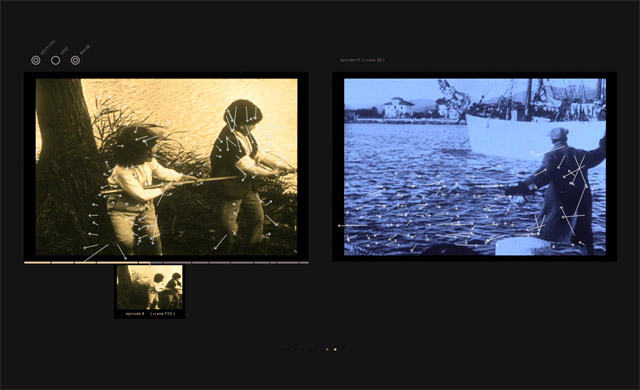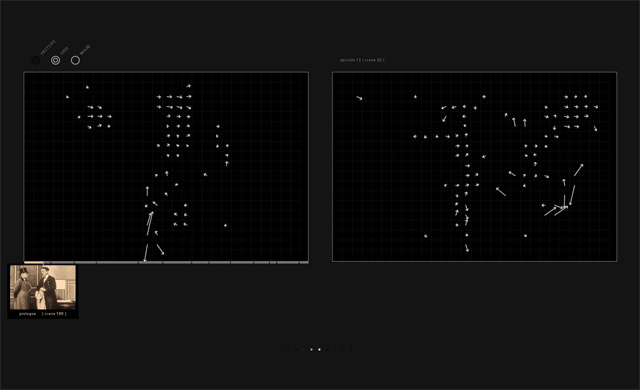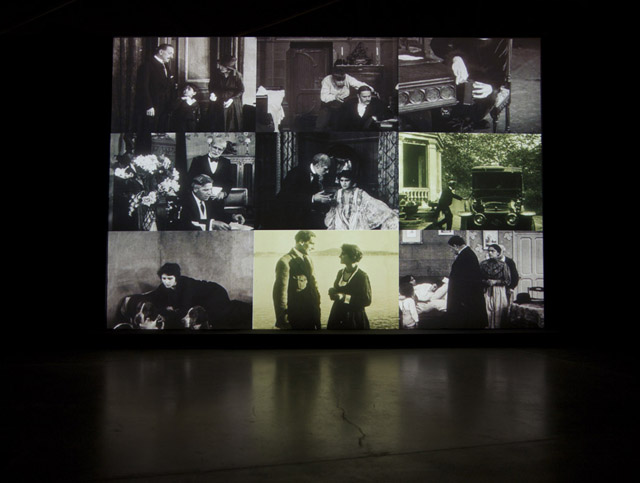ABOUT
Gestus is a moving image processing framework that uses computer vision techniques to explore the artistic possibilities of the vector as a symbolic form.
The following video explains the artistic procedure.
A vector is an abstraction of movement. It is essentially characterized by two
properties, magnitude and direction, and is often visualized as an arrow of a certain
length and orientation. The vector provides a sort of common currency that renders
distinct movements quantitatively commensurable.
Gestus consists of a custom software that generates a vector analysis of the movements
of videos in a database, identifying sequences that contain similar
micro-movements.
The current database contains shots from Louis Feuillade’s 1916 film Judex.
The software can be exhibited in two ways. The first is an interactive version with
two-windows. The left window displays the entire movie (over five hours of footage)
from start to finish. Users can drag a cursor on a time bar to advance or rewind
the movie. The software then searches for a shot that matches the motion of the
current image, and displays it on the right window. This setup encourages viewers
to pay close attention to the two images, trying to identify the similarities between
them.
Whereas our experience of the cinema is normally directed towards people, objects, and events, Gestus encourages spectators to pay close attention to movement. Sometimes one has to recognize that two different objects, such as a person and a river, or a dog and a tree branch moving in the wind, are moving in the same way.
Gestus opens up the domain of micro-movement, focusing attention on the tiny
motion of an eyelash or a finger. It cues the viewer to engage in an active process of
visual thinking, comparing the two images in an effort to identify the similarities between
them. Her perceptual effort becomes an integral element of the vector's machine.
Sometimes, the viewer easily detects similarities but in
other cases the movements are very subtle and occur in different areas of a crowded
image, posing a sharper perceptual challenge. Perhaps a dropping hand near the bottom of
one image corresponds to a leaning shoulder near the left edge of another. The viewer’s
gaze becomes restless as it scans simultaneous images, attempting to identify analogous
movements. The system invites, challenges, and sometimes frustrates the spectator’s
cognitive-perceptual skills.
Users can also turn off the image and simply view the vector field that forms the basis
for the comparison.
Another mode of presenting the work involves a 9-image grid. The movie runs from beginning to end in the center of the screen. The 8 shots (from the same film) whose movements most closely match those in the current shot are arranged around it.
The work was premiered in Hong Kong, as part of an exhibition curated by Robin Peckham in the Run Run Shaw Creative Media Centre of the City University of Hong Kong. The interactive display and the 9-image version were shown together.
Setup diagrams can be viewed here.
A more detailed technical description of the method used to perform the
movement analysis is available here.
There are several reasons why Feuillade’s Judex was selected for this work.
Feuillade worked within a tradition of ‘tableau cinema’ that relied on deep space
staging rather than camera movement or analytical editing. As film scholar David Bordwell has noted, this approach creates
dynamically changing geometric arrangements of bodies in space, carefully directing
the viewer’s gaze to salient features of a scene on a moment-to-moment basis. “Such
gentle geometries of movement hard to find in today’s cinema, and observing them in
Feuillade reminds us that long ago some directors crafted their images as two-dimensional
patterns of bodies in space.”
(1)
By focusing attention on the magnitude and direction of movement rather than its
iconic content, Gestus foregrounds the rhythmic quality of Feuillade’s deep
space orchestrations.
__________________________________________________________________________________________________________
(1) David Bordwell, “Revising Our Sense of Feuillade”, Retrieved September 1, 2011,
from http://www.davidbordwell.net/books/figures_intro.php?ss=2





